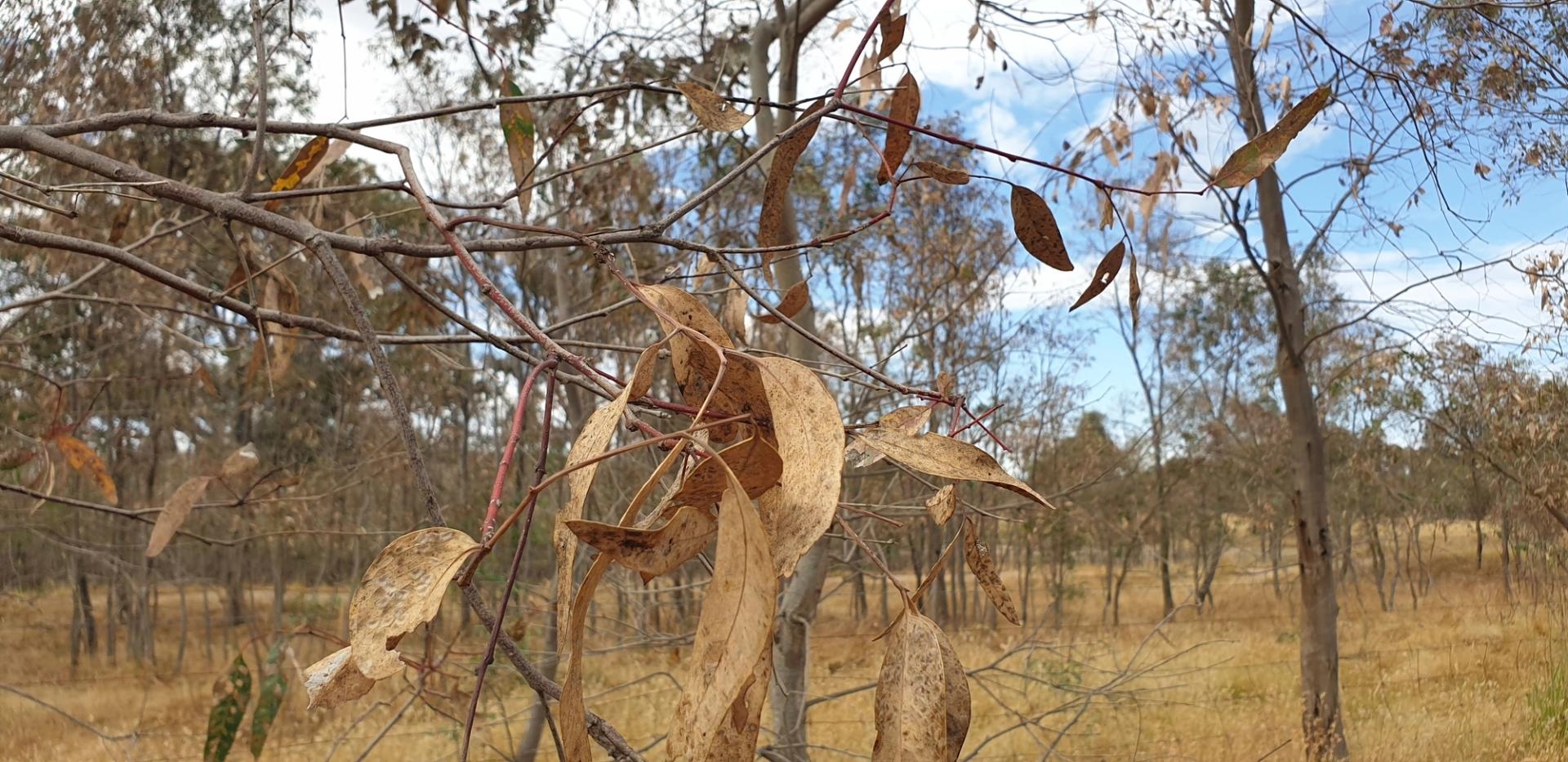5 December 2023
There are several noticeable patches of unhealthy or dead looking river red gums around our area. We've seen or heard folks report large clumps in Elhmurst, along Great Western Hwy between Ararat and Great Western, and just down the road from my house. Considering we have had quite a good couple years of rainfall, these dead patches are surprising and quite noticeable. And it is not restricted to young trees, even quite large mature trees are looking quite rough in these patches. So what is the cause?
I had a closer look at some of the dead trees near Rhymney, and there's no 'smoking gun' to find as far as the cause. Other than a few aphids and leaf hoppers hanging out on some of the still green leaves and new sprigs of growth, things were pretty quiet. Some of the trees are bearing heavy amounts of damage by 'leafmining' moths (a type of moth that tunnels around in eucalypt leaves before cutting out perfect little ovals to glue together into little 'leaf cocoons'). But seeing damage from these moths is not at all unusual. There don't seem to be any unusual numbers of pests in the eucalypts at the moment.
Then again, many of the dead trees had no leafminer moth damage at all, so they can't get all the blame.
There is another type of native insect which may be another culprit. We found some articles from Victorian entomologists over the last few years that suggest we may have recently had perfect conditions for a flair up of an insect called a psyllid. Despite not seeing any now, it is possible the psyllids had a population boom earlier in the year, and the damage they've left behind is just becoming more visible now as the dead leaves dry up and turn brown in the warm dry weather.
A psyllid is a'sap sucking' insect, related to aphids, which has a sharp straw like mouthpart they use to tap into the stems and leaves of plants and sip out the nutrient rich liquids. Psyllids have two life stages - the juvenile (or 'nymph' form) and the adult form. The adults are quite small, and have long bodies and wings. Juveniles are even smaller, rounder and lack wings. But you are unlikely to see the juveniles, because they live inside their own home made 'gingerbread house.' (How appropriate for Chrsitmas!) And by that I mean it is a house built out of sugar (and wax). Sounds delicious! These houses are called 'lerps'. They come in many colours, some brown and sea shell like, some white and twirly like wool. If you lift them up, you will find a tiny psyllid nymph underneath, sucking plant juices from the leaf.
If these psyllids (and leafminers) are native, shouldn't our eucalypts have evolved to deal with their presence?
Here are some thoughts from Dr. Greg Kerr at the Nature Glenelg Trust, after similar tree deaths were observed at Walker Swamp in 2020:
"A small attack on trees will result in some leaf discolouration, wilting and distortion in the tree foliage, but severe infestations by lerp-type psyllids cause extensive foliage discolouration in tree crowns with purple to brown/rusty red spots, leading ultimately to leaf death and defoliation. As psyllids are most active during the summer period, attacked foliage tends to desiccate rapidly due to the warm conditions so that by late summer leaf fall has accelerated to the point where tree crowns carry little foliage. In severe situations tree crowns are totally defoliated."
Dr. Greg Kerr also had some suggestions about why these native insects, which are always present, can some years grow to such numbers that they can defoliate even mature trees:
"The available literature suggests that a correlation may exist between outbreaks of psyllids on River Red Gums and a succession of dry summers combined with very wet winters within the same year. Despite not being excessively wet, these are the conditions that we have broadly experienced at Walker Swamp and the surrounding region over the last two years. In situations where psyllid attack has been particularly severe, tree death may ensue, often in conjunction with secondary insect pests and excessive levels of mistletoe infesting the weakened trees."
There are similar stories from other parts of Australia, such as in the Victorian Alps where die off of snow gums seem to be resulting from a trifecta of drought, fire and native beetle infestations.
Long story short, we really can't say for certain what is causing the tree deaths. And it is most likely a combination of more than one factor.
Even though native insect attacks on eucalypts are a natural process, the sensitivity of trees to these attacks could by exacerbated by changes in rainfall and drought intensity in future years. This could mean that we see these native insect-driven die offs become more frequent. There may not be much we can do to protect the eucalypts from native insects directly, but we can still work together to reduce the impact that we as humans have on changing climates and habitat loss, to soften the blow of these extreme events on our native species.
We'd love to hear from you if you have other insights on the tree deaths.

Elia Pirtle
Landcare Facilitator
